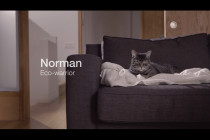As the confetti settles and Katy Perry’s golden lion returns to its cage, Super Bowl 2015 has proven itself history-making for a couple reasons. Not only was it the most watched television show in U.S. history with an average 114.4 million viewers, but it was also the first Super Bowl game lit with LEDs. Now, it will be near-impossible to prove that the two are related; no doubt the close score and nail-biting finish had everything to do with the record-breaking viewership, but I can’t resist an opportunity to point out how LEDs helped make Super Bowl 2015 a shining success this year.
Last year, sports lighting company Ephesus Light switched out the University of Phoenix Stadium’s traditional metal halide lamps, used to illuminate the 110-metre field surface, for new Cree LED fixtures. Because LEDs are more efficient, the 780 metal halide lights were replaced by only 312 LED units. Ephesus estimates the switch will result in a reduction in the stadium’s lighting consumption “from 1.24 million watts to 310, 000 watts,” which is an energy savings of roughly 75%. Given that the Super Bowl is associated with over-the-top consumption on many levels—from outrageous half-time performances to budget-blowing commercials, and all the hot wings and nachos in between—cost savings due to increased energy efficiency may seem moot, but what about some of the other advantages to an LED-lit Super Bowl?
According to the Ephesus team, the new LED fixtures “provide brighter, more uniform lighting… and better colour accuracy.” The improved light quality results in an improved viewing experience as follows:
- Since LEDs don’t flicker the same way as metal halide lamps, there isn’t a “strobe effect” visible during slow-motion replays.
- With brighter light, camera operators don’t need to open the aperture as wide on their cameras, which arguably means a clearer picture for viewers at home.
- Metal halide lights can take up to 20 minutes to warm up and fully illuminate, whereas LED fixtures light up instantly. If ever there was another Super Bowl blackout like the one experienced in 2013, an LED-lit stadium would recover immediately without a costly warm-up delay.
It seems improved energy efficiency and a better viewing experience did little to help the Seattle Seahawks (or the dancing shark on Katy Perry’s left) at this year’s Super Bowl, but the University of Phoenix Stadium’s commitment to sustainability and efficient design has helped cast a spotlight on the power of LED—to the tune of 114.4 million people!
About The Author

-
Serial Entrepreneur, Technologist and Inventor.
My objective is to develop useful products that have a net positive effect in the lives of those that use them and the environment that we live in.
CEO of Mission LED Lighting Company Ltd.
- 2017.05.24LED factsWhy Are Cars Switching to LEDs if They’re Too Bright?
- 2017.05.09Be green & saveHow to Easily Replace T8 Fluorescent Tubes With LED
- 2017.03.07Build a better future7 Things About Explosion Proof LED Lighting You Should Know
- 2017.02.28Be green & saveWhy We Love LED Grow Lights (And You Should, Too!)





Storm
It’s great to read something that’s both enjoyable and provides prgaamtisdc solutions.
Reply